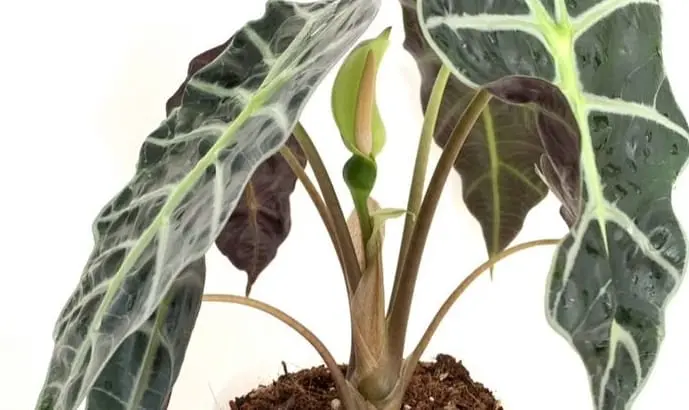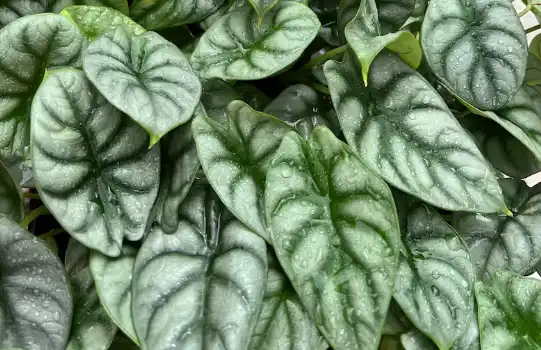Alocasia amazonica polly care, propagation – All you need to know
If you find some difficulties regarding the maintenance of your alocasia Polly or you are not buying it just because you don’t know how to handle it. This article is only for you.
Alocasia Pollyoriginates in the rainforests of Southeast Asia where they get filtered sunlight through plant canopies. Its water requirement depends on environmental factors such as the amount of light and the humidity level. Again it requires moist soil moist and balanced fertilization during the Summer months when the plant is in full growing mode.
You will get all the necessary information here regarding its availability. So keep scrolling and grab what you need.
Alocasia amazonica poly overview
| Scientific name | Alocasia amazonica ‘Polly’ |
| Family | Araceae |
| Common name | Alocasia bambino, alocasia X amazonica, kris plant, Alocasia Polly, Amazonian Elephant’s Ear, African Mask Plant |
| Origin | Alocasia amazonica Polly is a subspecies of hybrid alocasia amazonica (Alocasia longiloba Χ Alocasia sanderiana). Both Alocasia longiloba and Alocasia sanderiana are naturally found in rainforests in SouthAsia |
| Plant type | Perennial, herbaceous |
| Foliage | Arrow shaped, Glossy green with creamy-white vein |
| Sunlight | Bright indirect sunlight |
| Watering | Average (once a week) |
| Soil | evenly moist and well-draining |
| Humidity | 60 – 75% |
| Temperature | 64 to 77ºF (18 to 25ºC) |
| Fertilizer | well-balanced liquid fertilizer usually once a month during growing season |
Where to buy Alocasia amazonica Polly?
You can get Alocasia Polly in your nearby plant shop or nursery. But if you don’t want to go to the shop you can just order Alocasia ‘Polly’ from an online shop like Etsy.

Alocasia amazonica Polly care
Alocasia Polly is known to be an easy-maintenance plant. You can help your alocasia Polly to thrive by just maintaining a balanced care routine especially when it comes to light and moisture. It will be good if you can supply this tropical plant with growing conditions as close to the rainforest.
Light requirement for Alocasia amazonica Polly
Being a species of rainforest, alocasia Polly requires bright indirect light to flourish. A little bit of morning sun or filtered sunlight is great, but keep this plant away from harsh, direct sunlight otherwise the leaves may get burnt or bleach out their color.
Place it directly in an east or north-facing window where it will receive the less intense morning light.
Watering Guide for Alocasia amazonica Polly
Alocasia Polly requires moderate watering (once a week). Just ensure the topsoil is moistened. A great way to ensure sufficient watering of your alocasia is to wait for the top inch or half-inch of the soil to become dry to the touch. Both over and underwatering may cause leaf yellowing.
Soil for Alocasia amazonica Polly
Alocasia Polly prefers evenly moist and well-draining soil otherwise waterlogged conditions would lead to root rot. Ideal potting mixture for alocasia Polly :
- 5 parts orchid bark
- 1 part perlite
- 1 part sphagnum moss
The ideal soil pH range for Alocasia Polly is 5.5 to 6.5 (mild acidic soil).
Temperature for Alocasia amazonica Polly
The best temperature for maintaining proper growth and development of Alocasia Polly is 64 to 77ºF (18 to 25ºC). Low temperatures would lead them to go into hibernation.
Again don’t place your alocasia Polly near an AC or heater otherwise it would dry out.
Humidity for Alocasia amazonica Polly
The ideal humidity for Alocasia Polly is between 60 and 75% which is quite difficult to maintain in indoors special during dry seasons. The best way to raise humidity is to use a humidifier. regular spraying or the use of a humidity tray with pebbles and a layer of water is also recommended.
Fertilizer for Alocasia amazonica Polly
It is recommended to fertilize Alocasia Polly monthly with any well-balanced liquid fertilizer during the growing season( spring and summer). First, dilute it to half the recommended strength and then apply to avoid burning the roots.
Repotting Alocasia amazonica Polly
Repot your alocasia Polly every 2 or 3 years to avoid the root-bound conditions. Though it does not mind being a little root-bound. At the same time repotting gives you an opportunity to divide the roots to propagate more plants.
Every time you repot you must refresh the potting soil as well.
Alocasia amazonica Polly propagation
Alocasia ‘Polly’ can easily be propagated by dividing the rhizome which is also known as root division. Stem cuttings will not produce new plants. You can get new plants through root division while repotting following the steps below:
Removal of the mother plant: Pull the root ball out of the pot and shake and shake the plant to remove soil.

Separation of baby corms: A tangle of individual rhizomes is found to be twisted together. Gently separate them by hand or you can cut them by using a sterilized knife.
Planting the corm in a new pot: Plant the corms individually. You can plant them directly on the ground or in the pot. In the case of indoors, place the plant in warm and indirect sunlight.
Establishment of new plant: In a couple of weeks, the plant will develop roots and establish itself well in the soil.
You can also use plantlets that have both roots and leaves as baby plants.

Why are my Alocasia amazonica Polly leaves drooping?
Your Alocasia Polly may be drooping because it needs water. It occurs when the soil has dried out too much.
Tips : To avoid leaf drooping water your Alocasia polly whenever the top inch of the soil is dry. Watering at least once a week during the growing season is recommended.
Why are my Alocasia amazonica Polly leaves curling?
If you see your alocasia polly’s leaves are curling up, there may be two condition responsible for it:
- lower humidity and
- less bright light
Tips : provide your alocasia with an higher humid condition you can use pebble tray method or you can also mist your plant. And put you alocasia near a north facing window where it will get bright indirect sunlight.
Why are my Alocasia amazonica Polly leaves dying?
Youmay often find that your Alocasia Polly’s leaves are dying off, it is due to the condition of not get proper growing environment especially there’s a good chance that it’s not in a warm enough spot.
Tips : Move it to a warmer place and maintain sufficient sufficient light arrangement to overcome this problem
Alocasia amazonica polly vs Alocasia baginda ‘dragon scale’
Alocasia baginda ‘dragon scale’ is a unique variety of alocasia. It is a lovely evergreen plant with an oval shape and large silver-green foliage. A darker vein can be found near the top of the leaf; such appearance resembles the scale of a dragon. On the other hand Alocasia Polly is a popular houseplant because of its compact size with deep green, waxy leaves with bold cream-colored lines.
Alocasia amazonica Polly vs Alocasia reginula ‘Black Velvet’
Comparing alocasia Polly and alocasia black velvet the Black velvet is way smaller in size. However, it is also known as a miniature jewel because of its attractive foliage that bears silvery-white veins and the alocasia Polly has dark green, glossy leaves with sharply contrasting veins.
Alocasia amazonica Polly vs Alocasia Nebula
Alocasia Polly is a beautiful plant and very easy to recognize its eyecatching foliage: arrow-shaped and very dark green with lighter, creamy green midribs.On the other hand, Alocasia Nebula has fascinating silvery gray or deep blue leaves with two lines of patterning. It has thick and exquisite type of leaves.
FAQs
Is Alocasia amazonica polly toxic?
Like many other houseplants of the Alocasia genus, alocasia Polly contains insoluble calcium oxalates, which can cause intense burning in the mouth and surrounding areas. Hence, it’s important to take caution when bringing this plant indoors.
Does Alocasia amazonica Polly have flowers?
Yes. Although their flowers aren’t very spectacular, these Alocasias do sometimes bloom in the home with the right care.

Is there any difference between alocasia amazonica and alocasia Polly?
Alocasia amazonica is a hybrid developed from a crossing between two species Alocasia longiloba Χ Alocasia sanderiana. And Alocasia amazonica Polly is a subspecies of this hybrid. They are mostly similar except for their size, Alocasia amazonica Polly is smaller in size than Alocasia Amazonica.
Final thoughts
Plants of the alocasia Polly family dweller in the rainforest of Southasia, therefore, for getting a healthy Alocasia Polly plant you have to provide growing conditions which is close to the rainforest
- Filtered light
- a moist environment
- relatively high temperatures
- Judicious fertilization during the active season( usually once a month)
- Well-drained peat-based growing media
These are discussed in details on the care section of the article. So, no more worries regarding the maintenance just get your favorite Polly from the above-mentioned website and keep spreading greenery.

![How to water Peace Lily while on vacation [Pro Tips]](https://diaryforgardening.com/wp-content/uploads/2022/09/Peace-lily-watering-on-vacation.webp)
![Philodendron pedatum care & propagation guide [step by step guide]](https://diaryforgardening.com/wp-content/uploads/2022/06/Philodendron-pedatum-care.jpg)


![Alocasia melo care, propagation, leaves problem [all you need to know]](https://diaryforgardening.com/wp-content/uploads/2022/09/Alocasia-Melo-Care.webp)

